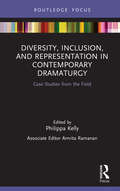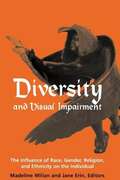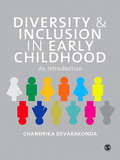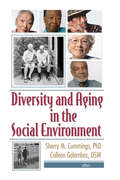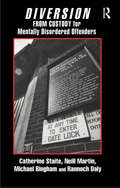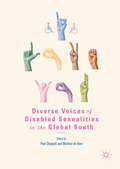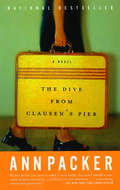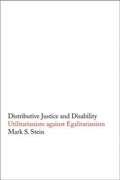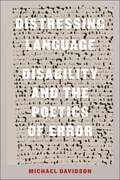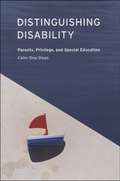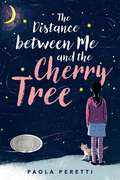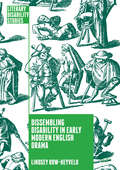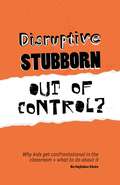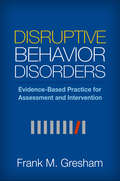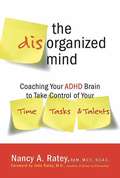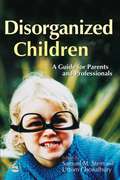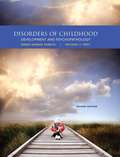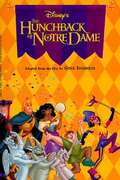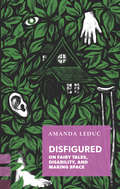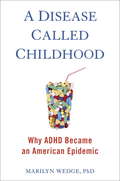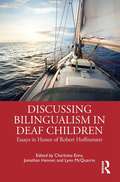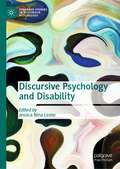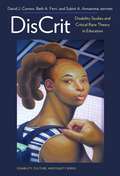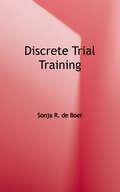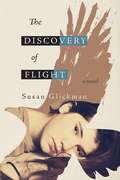- Table View
- List View
Diversity, Inclusion, and Representation in Contemporary Dramaturgy: Case Studies from the Field (Focus on Dramaturgy)
by Philippa Kelly Amrita RamananDiversity, Inclusion, and Representation in Contemporary Dramaturgy offers fresh perspectives on how dramaturgs can support a production beyond rigid disciplinary expectations about what information and ideas are useful and how they should be shared. The sixteen contributors to this volume offer personal windows into dramaturgy practice, encouraging theater practitioners, students, and general theater-lovers to imagine themselves as dramaturgs newly inspired by the encounters and enquiries that are the juice of contemporary theater. Each case study is written by a dramaturg whose body of work explores important issues of race, cultural equity, and culturally-specific practices within a wide range of conventions, venues, and communities. The contributors demonstrate the unique capacity of their craft to straddle the ravine between stage and stalls, intention and impact. By unpacking, in the most up-to-date ways, the central question of “Why this play, at this time, for this audience?,” this collection provides valuable insights and dramaturgy tools for scholars and students of Dramaturgy, Directing, and Theater Studies.
Diversity and Visual Impairment: The Influence of Race, Gender, Religion, and Ethnicity on the Individual
by Madeline Milian Jane N. ErinA scholarly collection of insightful essays which look at how visual impairment interacts with certain social characteristics to affect human personalities.
Diversity and Inclusion in Early Childhood: An Introduction
by Chandrika DevarakondaCovering a wide range of concepts and taking a broader perspective of what inclusion entail, this book offers an overview of current research, policy and practice in diversity and inclusion in the early years. It is a clear introduction to what inclusive practice means for those working with young children in the early stages of their lives. With case studies and activities designed to help students relate to diverse situations, the author discusses the main issues surrounding: - race - gender - culture - disability and Special Educational Needs - English as an Additional Language - Traveller children - the contexts of inclusion and exclusion - good practice in early childhood settings - different perspectives of inclusion This is essential reading for students studying inclusion and diversity on early childhood or early years courses, and those seeking to promote good practice and enable all children to develop to their full potential irrespective of their background. 'The success of this book is in its ability to explore inclusion from a wide perspective. Offering a range of thought-provoking material, such as reflective questions, debates and controversies, practitioner, parent and children's views, legislation, activities, and examples of good practice, will keep readers interested and actively engaged throughout the book'-Dr Anna Kilderry, Senior Lecturer, Early Childhood Education, Victoria University, Melbourne, Australia Chandrika Devarakonda is a Senior Lecturer in the Faculty of Education and Children's Services at the University of Chester.
Diversity and Aging in the Social Environment
by Sherry M. Cummings Colleen GalambosToday, nearly one of every eight Americans is 65 or older, and by 2030, over 20% of the population will be in this age group. Are you prepared to work with this vastly diverse-and rapidly growing-population?This single source is designed to help social service professionals provide effective services to America&’s vastly diverse and rapidly growing elderly population. Diversity and Aging in the Social Environment explores the impact of race/ethnicity, gender, sexual orientation, and geographic location on elders&’ strengths, challenges, needs, and resources to provide you with a more complete understanding of the issues elders face. In order to be more responsive to older adults, social workers and other human service professionals need to enhance their knowledge of the aging population and the factors that impact the way seniors interact with society, organizations, community resources, neighborhoods, support networks, kinship groups, family, and friends. Diversity and Aging in the Social Environment examines differences in race, ethnicity, geographical location, sexual orientation, religion, and health status to help current and future human service professionals provide culturally competent services to the diverse range of elderly people they serve. In addition, it addresses the wide disparity that exists for older Americans in terms of income and assets, number of chronic conditions, functional and cognitive impairment, housing arrangements, and access to health care. This book provides a context for the examination of diversity issues among older adults by describing and discussing several theoretical perspectives on aging that highlight important aspects of diversity. Next, you&’ll find thoughtful examinations of: issues and challenges faced by lesbian, gay, bisexual, and transgender elders-and the strengths they bring into later life the impact of gender, race, and sexual orientation on prevalence rates, risk factors, methods of disease contraction, and mortality rates among older adults with HIV/AIDS-along with a discussion of the psychosocial issues they face diverse characteristics of custodial grandparents-and the influence of the caregivers&’ gender, race, age, and geographic location on methods of care and available caregiver support differences in caregiver characteristics, service utilization, caregiver strain, and coping mechanisms among several racial/ethnic groups of adults who care for elderly, disabled, and ill persons cultural/religious factors that influence interactions between health care personnel and Japanese-American elders the relationship between acculturation and depressive symptoms among Mexican-American couples life challenges facing Jewish and African-American elders-with a look at each group&’s coping mechanisms differences in religious/spiritual coping skills among Native American, African-American, and white elders psychological well-being and religiosity among a diverse group of rural elders
Diversion from Custody for Mentally Disordered Offenders: A Practical Guide
by Catherine Staite Neill Martin Rannoch DalyThe authors aim to provide practical guidance to enable practitioners in the various criminal justice, health and social care agencies to divert mentally disordered offenders from prosecution and custody and to help prevent re-offending.
Diverse Voices of Disabled Sexualities in the Global South
by Marlene De Beer Paul ChappellThis volume aims to critically engage with constructs and experiences of disabled sexualities through Africa, Asia, Latin America and the Caribbean. In doing so, it is hoped that the questions raised, relfections, analyses and arguments will provide readers with a catalyst through which to (re)think disabled sexualities from the perspective of the Global South. What makes this edited volume unique is besides chapters from emerging academics and disability activists who either live or work in the Global South, it also includes personal contributions from disabled people across the Global South. This volume takes a broad perspective on disabled sexualities addressing such areas as gender, race, culture, colonialism, body image, sexual pleasure, sexuality education, sexual access, sexual and reproductive health services, queer sexualities, and sexual rights and justice. The volume will be of interest to international and national organisations for people with disabilities, gender and sexuality researchers, health professionals, social workers, academics and students at all higher education and training institutions interested in disability, gender queer and sexuality studies.
The Dive from Clausen's Pier (Vintage Contemporaries)
by Ann PackerA riveting novel about loyalty and self-knowledge, and the conflict between who we want to be to others and who we must be for ourselves. Carrie Bell has lived in Wisconsin all her life. She’s had the same best friend, the same good relationship with her mother, the same boyfriend, Mike, now her fiancé, for as long as anyone can remember. It’s with real surprise she finds that, at age twenty-three, her life has begun to feel suffocating. She longs for a change, an upheaval, for a chance to begin again. That chance is granted to her, terribly, when Mike is injured in an accident. Now Carrie has to question everything she thought she knew about herself and the meaning of home. She must ask: How much do we owe the people we love? Is it a sign of strength or of weakness to walk away from someone in need? The Dive from Clausen’s Pier reminds us how precarious our lives are and how quickly they can be divided into before and after, whether by random accident or by the force of our own desires. It begins with a disaster that could happen, out of the blue, in anybody’s life, and it forces us to ask how we would bear up in the face of tragedy and what we know, or think we know, about our deepest allegiances. Elegantly written and ferociously paced, emotionally nuanced and morally complex, The Dive from Clausen’s Pier marks the emergence of a prodigiously gifted new novelist.
Distributive Justice and Disability: Utilitarianism Against Egalitarianism
by Mark S. SteinTheories of distributive justice are most severely tested in the area of disability. In this book, Mark Stein argues that utilitarianism performs better than egalitarian theories in this area: whereas egalitarian theories help the disabled either too little or too much, utilitarianism achieves the proper balance by placing resources where they will do the most good. Stein offers what may be the broadest critique of egalitarian theory from a utilitarian perspective. He addresses the work of egalitarian theorists John Rawls, Ronald Dworkin, Amartya Sen, Bruce Ackerman, Martha Nussbaum, Norman Daniels, Philippe Van Parijs, and others. Stein claims that egalitarians are often driven to borrow elements of utilitarianism in order to make their theories at all plausible. The book concludes with an acknowledgment that both utilitarians and egalitarians face problems in the distribution of life-saving medical resources. Stein advocates a version of utilitarianism that would distribute life-saving resources based on life expectancy, not quality of life. Egalitarian theories, he argues, ignore life expectancy and so are again found wanting. Distributive Justice and Disability is a powerful and engaging book that helps to reframe the debate between egalitarian and utilitarian thinkers.
Distressing Language: Disability and the Poetics of Error (Crip)
by Michael DavidsonThe role of disability and deafness in artDistressing Language is full of mistakes—errors of hearing, speaking, writing, and understanding. Michael Davidson engages the role of disability and deafness in contemporary aesthetics, exploring how physical and intellectual differences challenge our understanding of art and poetry. Where hearing and speaking are considered normative conditions of the human, what happens when words are misheard and misspoken? How have writers and artists, both disabled and non-disabled, used error as generative elements in contesting the presumed value of “sounding good”? Distressing Language grows out of the author’s experience of hearing loss in which misunderstandings have become a daily occurrence. Davidson maintains that verbal confusions are less an aberration in understanding than a component of new knowledge.Davidson discusses a range of sites, from captioning errors and Bad Lip Reads on YouTube, to the deaf artist Christine Sun Kim’s audiovisual installations, and a poetic reinterpretation of the Biblical Shibboleth responding to the atrocities of the Holocaust. Deafness becomes a guide in each chapter of Distressing Language, giving us a closer look at a range of artistic mediums and how artists are working with the axiom of “error” to produce novel subjecthoods and possibilities.
Distinguishing Disability: Parents, Privilege, and Special Education
by Colin Ong-DeanStudents in special education programs can have widely divergent experiences. For some, special education amounts to a dumping ground where schools unload their problem students, while for others, it provides access to services and accommodations that drastically improve chances of succeeding in school and beyond. Distinguishing Disabilityargues that this inequity in treatment is directly linked to the disparity in resources possessed by the students’ parents. Since the mid-1970s, federal law has empowered parents of public school children to intervene in virtually every aspect of the decision making involved in special education. However, Colin Ong-Dean reveals that this power is generally available only to those parents with the money, educational background, and confidence needed to make effective claims about their children’s disabilities and related needs. Ong-Dean documents this class divide by examining a wealth of evidence, including historic rates of learning disability diagnosis, court decisions, and advice literature for parents of disabled children. In an era of expanding special education enrollment,Distinguishing Disabilityis a timely analysis of the way this expansion has created new kinds of inequality.
The Distance between Me and the Cherry Tree
by Paola PerettiTen-year-old Mafalda hides the fact that she is going blind from her family and friends in this lyrical, bittersweet debut novel from Italian author Paola Peretti that shows you how to overcome the darkness—even when you can’t see the light at the end of the tunnel.There are a lot of things ten-year-old Mafalda cares a lot about. Like, counting the stars in the night sky, playing soccer, and climbing the cherry tree outside her school. Mafalda even goes so far as to keep a list of all these things, because soon she won’t be able to do them anymore—because she’s going blind. Even with her bad eyesight Mafalda can see that people are already treating her differently—and that’s the last thing she wants. So, she hides the fact that her vision is deteriorating faster than anyone predicted, and she makes a plan: When the time is right, she’ll go live in the cherry tree, just like her favorite book character. But as Mafalda loses her sight, surprising things come in to focus. With the help of her family and friends both old and new, Mafalda discovers the things that matter most.
Dissembling Disability in Early Modern English Drama (Literary Disability Studies)
by Lindsey Row-HeyveldWhy do able-bodied characters fake disability in 40 early modern English plays? This book uncovers a previously unexamined theatrical tradition and explores the way counterfeit disability captivated the Renaissance stage. Through detailed case studies of both lesser-known and canonical plays (by Shakespeare, Jonson, Marston, and others), Lindsey Row-Heyveld demonstrates why counterfeit disability proved so useful to early modern playwrights. Changing approaches to almsgiving in the English Reformation led to increasing concerns about feigned disability. The theater capitalized on those concerns, using the counterfeit-disability tradition to explore issues of charity, epistemology, and spectatorship. By illuminating this neglected tradition, this book fills an important gap in both disability history and literary studies, and explores how fears of counterfeit disability created a feedback loop of performance and suspicion. The result is the still-pervasive insistence that even genuinely disabled people must perform in order to, paradoxically, prove the authenticity of their impairments.
Disruptive, Stubborn, Out of Control?: Why kids get confrontational in the classroom, and what to do about it
by Bo Hejlskov ElvénOne of the biggest challenges in the classroom is trying to teach when students act in unexpected and annoying ways. Based on the psychology of how children and people act, this book offers practical strategies for understanding why your students are behaving in the way they are, and how to react in a way that restores peace and harmony in the classroom. With many examples of typical confrontational behaviours and clues for how to understand and resolve the underlying issues, this book will be every stressed teacher's best friend.
Disruptive Behavior Disorders
by Frank M. GreshamSchools often resort to ineffective, punitive interventions for the 10% of K-8 students whose challenging behavior interferes with their own and their classmates' learning. This book fills a crucial need by describing ways to provide meaningful supports to students with disruptive behavior disorders. Prominent authority Frank M. Gresham weaves together current research, assessment and intervention guidelines, and illustrative case studies. He reviews a broad range of evidence-based practices and offers recommendations for selecting, implementing, and evaluating them within a multi-tiered framework. Coverage includes school- and home-based approaches, multicomponent programs, prevention strategies, and social skills training.
The Disorganized Mind: Coaching Your ADHD Brain to Take Control of Your Time, Tasks, and Talents
by Nancy A. RateyFor the millions of adults diagnosed with ADHD The Disorganized Mind will provide expert guidance on what they can do to make the most of their lives. The inattention, time-mismanagement, procrastination, impulsivity, distractibility, and difficulty with transitions that often go hand-in-hand with ADHD can be overcome with the unique approach that Nancy Ratey brings to turning these behaviors around. The Disorganized Mind addresses the common issues confronted by the ADHD adult:"Where did the time go?""I'll do it later, I always work better under pressure anyway.""I'll just check my e-mail one more time before the meeting…""I'll pay the bills tomorrow – that will give me time to find them."Professional ADHD coach and expert Nancy Ratey helps readers better understand why their ADHD is getting in their way and what they can do about it. Nancy Ratey understands the challenges faced by adults with ADHD from both a personal and professional perspective and is able to help anyone move forward to achieve greater success. Many individuals with ADHD live in turmoil. It doesn't have to be that way. You can make choices and imagine how things can change – this book will teach you how. By using ADHD strategies that have worked for others and will work for you, as well as learning how to organize, plan, and prioritize, you'll clear the hurdles of daily living with a confidence and success you may never before have dreamed possible. Nancy Ratey has the proven strategies that will help anyone with ADHD get focused, stay on track, and get things done - and finally get what they want from their work and their life.
Disorganized Children: A Guide for Parents and Professionals
by Uttom Chowdhury Rebecca Chilvers Samuel SteinDisorganized children' may display a range of behaviours symptomatic of, for example, ADHD, autism and conduct disorders, but they often fail to meet all the criteria for a clear diagnosis. In this book, psychiatrists, speech, family and occupational therapists and neurodevelopment specialists present a range of behavioural and psychological strategies to help disorganized children improve concentration and performance in the classroom and deal with a variety of behaviour and social interaction difficulties. The authors also provide information and interventions for dyslexia, dyspraxia, OCD and schizophrenia, among others. The combination of information, exercises and case studies makes this a valuable tool for use by parents, health care and teaching professionals, and the authors provide an insight into the mind of disorganized children and practical guidance on how best to help them achieve their full potential.
Disorders of Childhood: Development and Psychopathology
by Robin Hornik Parritz Michael F. TroyWritten with the whole child in mind, this book discusses disorders in connection with the different stages of development, providing both a meaningful framework to promote learning. The authors emphasize multi-factor explanations of disorders as well as developmental frameworks and developmental pathways--presenting disorders and sets of disorders in the order in which they typically appear in a child's life. They also focus on the child-in-context (calling attention to the multiple settings in which the child is embedded) and emphasize the importance of taking a broad view that considers the whole child and his or her patterns of interest, abilities, and strengths, rather than a narrow view of a disorder or developmental delay. As a result of this holistic approach, which reflects the most up-to-date understanding of child and adolescent psychopathology, readers learn to think about disorders in the same way that caring adults think about disorders they encounter every day--in terms of an individual child who is coping with distress and dysfunction. Available with InfoTrac Student Collections http://gocengage.com/infotrac.
Disney's The Hunchback of Notre Dame (Junior Novelization)
by Gina IngogliaSet in the picturesque Parisian streets of the fifteenth century, this adventure centers on Quasimodo, the gentle and lonely hunchbacked bell-ringer confined to the tower of the Notre Dame cathedral. Quasimodo finds a friend in the gypsy Esmeralda.
Disfigured: On Fairy Tales, Disability, and Making Space (Exploded Views)
by Amanda LeducFairy tales shape how we see the world, so what happens when you identify more with the Beast than Beauty? If every disabled character is mocked and mistreated, how does the Beast ever imagine a happily-ever-after? Amanda Leduc looks at fairy tales from the Brothers Grimm to Disney, showing us how they influence our expectations and behaviour and linking the quest for disability rights to new kinds of stories that celebrate difference. "Leduc persuasively illustrates the power of stories to affect reality in this painstakingly researched and provocative study that invites us to consider our favorite folktales from another angle." —Sara Shreve, Library Journal
A Disease Called Childhood
by Marilyn WedgeA surprising new look at the rise of ADHD in America, arguing for a better paradigm for diagnosing and treating our children In 1987, only 3 percent of American children were diagnosed with attention-deficit/hyperactivity disorder, also known as ADHD. By 2000, that number jumped to 7 percent, and in 2014 the number rose to an alarming 11 percent. To combat the disorder, two thirds of these children, some as young as three years old, are prescribed powerful stimulant drugs like Ritalin and Adderall to help them cope with symptoms. Meanwhile, ADHD rates have remained relatively low in other countries such as France, Finland, and the United Kingdom, and Japan, where the number of children diagnosed with and medicated for ADHD is a measly 1 percent or less. Alarmed by this trend, family therapist Marilyn Wedge set out to understand how ADHD became an American epidemic. If ADHD were a true biological disorder of the brain, why was the rate of diagnosis so much higher in America than it was abroad? Was a child's inattention or hyperactivity indicative of a genetic defect, or was it merely the expression of normal behavior or a reaction to stress? Most important, were there alternative treatments that could help children thrive without resorting to powerful prescription drugs? In an effort to answer these questions, Wedge published an article in Psychology Today entitled "Why French Kids Don't Have ADHD" in which she argued that different approaches to therapy, parenting, diet, and education may explain why rates of ADHD are so much lower in other countries.In A Disease Called Childhood, Wedge examines how myriad factors have come together, resulting in a generation addictied to stimulant drugs, and a medical system that encourages diagnosis instead of seeking other solutions. Writing with empathy and dogged determination to help parents and children struggling with an ADHD diagnosis, Wedge draws on her decades of experience, as well as up-to-date research, to offer a new perspective on ADHD. Instead of focusing only on treating symptoms, she looks at the various potential causes of hyperactivity and inattention in children and examines behavioral and environmental, as opposed to strictly biological, treatments that have been proven to help. In the process, Wedge offers parents, teachers, doctors, and therapists a new paradigm for child mental health--and a better, happier, and less medicated future for American children
Discussing Bilingualism in Deaf Children: Essays in Honor of Robert Hoffmeister
by Charlotte EnnsThis collection unites expert scholars in a comprehensive survey of critical topics in bilingual deaf education. Drawing on the work of Dr. Robert Hoffmeister, chapters explore the concept that a strong first language is critical to later learning and literacy development. In thought-provoking essays, authors discuss the theoretical underpinnings of bilingual deaf education, teaching strategies for deaf students, and the unique challenges of signed language assessment. Essential for anyone looking to expand their understanding of bilingualism and deafness, this volume reflects Dr. Hoffmeister’s impact on the field while demonstrating the ultimate resilience of human language and literacy systems.
Discursive Psychology and Disability (Palgrave Studies in Discursive Psychology)
by Jessica Nina LesterThis book explores how discursive psychology (DP) research can be applied to disability and the everyday and institutional constructions of bodymind differences. Bringing together both theoretical and empirical work, it illustrates how DP might be leveraged to make visible nuanced understandings of disability and difference writ large. The authors argue that DP can attend to how such realities are made relevant, dealt with, and negotiated within social practices in the study of disability. They contend that DP can be used to unearth the nuanced and frequently taken for granted ways in which disability is made real in both everyday and institutional talk, and can highlight the very ways in which differences are embodied in social practices – specifically at the level of talk and text. This book demonstrates that rather than simply staying at the level of theory, DP scholars can make visible the actual means by which disabilities and differences more broadly are made real, resisted, contested, and negotiated in everyday social actions. This book aims to expand conceptions of disability and to deepen the – at present, primarily theoretical – critiques of medicalization.
DisCrit: Disability Studies and Critical Race Theory in Education
by David J. Connor Beth A. Ferri Subini A. AnnammaIn this groundbreaking volume, scholars examine the achievement/opportunity gaps from both historical and contemporary perspectives, as well as the overrepresentation of minority students in special education and the school-to-prison pipeline. Chapters also address school reform and the impact on students based on race, class, and dis/ability and the capacity of law and policy to include (and exclude).
Discrete Trial Training
by Sonja R. DeBoerDiscrete trial training (DTT) is a method of teaching individuals with autism spectrum disorder (ASD) based on applied behavior analysis (ABA). Skills are broken into discrete steps and then taught in massed trials. With DTT, steps are taught one at a time, instead of teaching an entire skill all at once. Concepts covered include errorless learning, methods of reinforcement, and how to use behavior momentum. The text explains how to collect, interpret, and use data to make teaching decisions. Finally, the text details a method for evaluating implementation of DTT.
The Discovery of Flight (13c. Teen Gold( Cats Parade) #851)
by Susan GlickmanTwo threads comprise this young-adult novel, originally published in Canada. One is a journal that spans one school year in the life of twelve-year-old Sophie, and the other is the novel her sister, Libby is writing for her as a birthday surprise. Libby, who has cerebral palsy, communicates through the use of a computer. Sophie writes about school, friendship, preparing for her Bat Mitzvah, and her sister's deteriorating health. Libby's novel is a fantasy about the relationship between a girl and a hawk.
